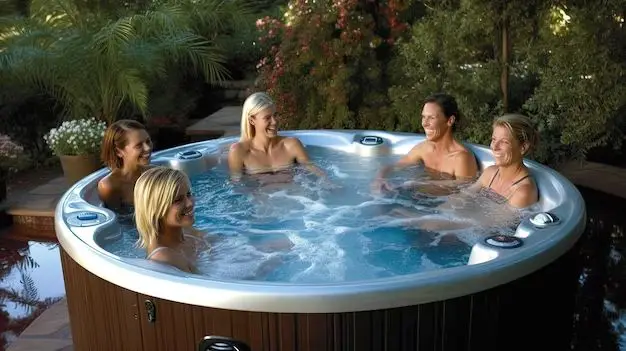Having a hot tub can be a great way to relax and unwind at home. However, hot tubs do require regular maintenance to keep the water clean and your hot tub in good working order. When shopping for a new hot tub, it’s important to consider what type will be the easiest for you to maintain long-term.
Page Contents
Key Factors That Impact Hot Tub Maintenance
There are a few key factors that determine how much routine maintenance a hot tub will require:
- Size – Larger hot tubs hold more water, which needs to be filtered and chemically treated. Smaller tubs are quicker and easier to clean.
- Number of jets – More jets mean more places where bacteria can grow. Fewer jets reduce cleaning time.
- Materials – Synthetic materials like acrylic are nonporous and resist staining/buildup. Wood tubs absorb more oil and debris.
- Water sanitation system – Advanced systems with ozonators or UV reduce chemical usage. Simple systems rely more on chlorine/bromine.
- Filtration system – Effective filtration removes contaminants and cuts back on chemical usage. Inadequate filtration increases maintenance needs.
Keep these factors in mind as you consider which type of hot tub will have the lowest maintenance requirements for your needs.
Easiest to Maintain Hot Tub Types
Smaller Hot Tubs
One of the biggest factors determining ongoing hot tub maintenance is simply the size of the tub. Smaller hot tubs have less water volume to filter, heat, and chemically treat compared to larger tubs. A good rule of thumb is to choose the smallest size that will realistically fit your needs.
One or two-person hot tubs with a capacity of 200-300 gallons are easier to care for than larger 5-7 person tubs holding 400+ gallons. You’ll save time each week cleaning filters, adding chemicals, changing water, and more with a compact tub.
Above-Ground Hot Tubs
Above-ground hot tubs that sit outside on a patio or deck typically require less maintenance than in-ground spas. With above-ground tubs, it’s easier to access equipment for regular maintenance. The entire inner shell can be cleaned and sanitized. Portable tubs can also be drained and moved as needed.
In-ground hot tubs installed below patio/yard level have more limited access. Some equipment may be buried or hard to reach. The inner surfaces are harder to scrub and keep clean. All told, above-ground portable tubs allow for quicker maintenance.
Acrylic Hot Tubs
Acrylic is the most common material used to make modern hot tub shells. Acrylic is lightweight, durable, and easy to clean. It resists bacteria growth and mineral buildup better than other materials like wood or fiberglass.
Over time, small scratches and dings can form on acrylic surfaces. These don’t affect hygiene and are easily buffed out. With proper care, an acrylic hot tub shell will maintain its smooth, shiny finish for years.
Advanced Filtration Systems
Effective filtration is key to lowering hot tub maintenance needs. Advanced filtration uses dual filters plus supplemental systems like ozonation and UV sanitation.
Dual filters mean water passes through two filter stages – first through an outer pleated filter to remove larger particles, then through an inner cartridge filter for finer contaminants. This produces clearer water.
Ozone generators and UV sanitizers further reduce bacteria and chemicals needed. The best self-cleaning hot tub models have multi-stage filtration plus ozone and UV systems built in.
Microban Antimicrobial Protection
Some hot tub manufacturers add antimicrobial Microban coating to their acrylic tubs and other components. Microban helps prevent the growth and spread of bacteria, mold, fungi, and other microorganisms.
Treated surfaces resist stain and odor buildup better than untreated surfaces. Microban protection helps reduce the need for chemical sanitizers over time, making maintenance easier.
Routine Hot Tub Maintenance Tasks
While certain types of hot tubs require less overall maintenance, all hot tubs will need some degree of regular care and cleaning. Here are some routine hot tub maintenance tasks all owners should expect and budget time for:
Monitoring and Adjusting Water Chemistry
Test and adjust the hot tub water’s pH, alkalinity, and sanitizer (chlorine/bromine) levels at least weekly. Use test strips or electronic testing devices to check levels. Add pH up/down and sanitizing chemicals as needed to maintain proper water balance.
Cleaning Filters
Hot tub cartridge filters should be removed and rinsed off at least once a week. Soak in a filter cleaning solution regularly for a deeper clean. Change filters every 3-6 months.
Shocking the Water
Using a chlorine or non-chlorine shock treatment weekly helps maintain sanitization between regular hot tub uses. Shocking oxidizes contaminants and improves water clarity.
Changing the Water
Draining and refilling your hot tub with fresh water every 3-6 months removes dissolved solids that can build up over time. More frequent water changes may be needed with heavier tub usage.
Cleaning Surfaces
Wipe down hot tub seats, walls, controls, and surrounding surfaces with a non-abrasive cleaner designed for spas weekly or as needed. Thoroughly clean and disinfect all components every 3-6 months.
Safety Inspections
Check that all hot tub components – pumps, heater, jets, lights, controls, etc. – are operating safely each week. Have a professional technician do detailed inspections and repairs every 1-2 years.
Conclusion
The easiest to maintain hot tubs have a smaller water capacity, above-ground portable design, antimicrobial acrylic shell, advanced filters, and self-cleaning capabilities. But all hot tubs require weekly monitoring and cleaning of some kind.
Buying a tub designed for convenience can minimize the time and effort needed for hot tub upkeep. Focus on models with quick-access panels and filtration, antimicrobial components, and simple water care systems.
With the right hot tub for your lifestyle and a regular maintenance routine, it’s possible to enjoy the benefits of home hydrotherapy with minimal hassle.
